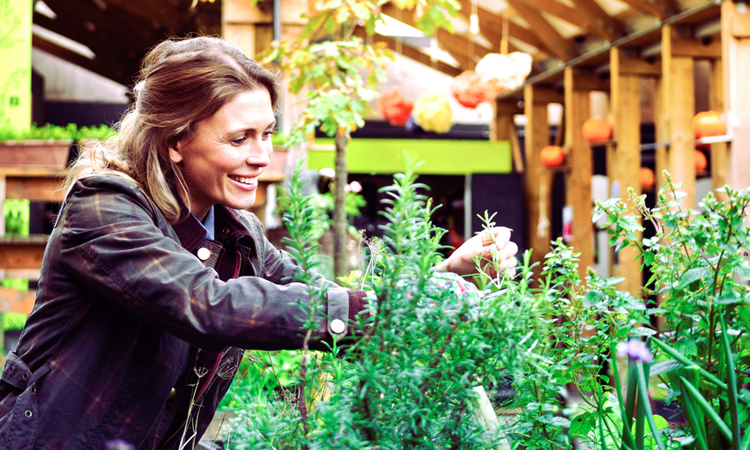Who doesn’t feel a bit stressed or in a funk from time to time? It has become the cultural norm to live a fast-paced, high-stress life. We don’t sleep as much as we should. We usually work more than we should, play and relax too little, overfeed yet under-nourish our bodies, and generally do everything in our power to make the nervous-adrenal system cranky. This leaves us cranky. Experiencing fatigue, insomnia, mood funks and anxiety are all too common in the United States. And chronic stress leads to a host of other health issues.
While this actually warrants a lifestyle overhaul, we do have various herbs at our disposal to soften the blow of stress, boost the mood and ease our transition into a better mindset. Two categories of herbs fit nicely here: adaptogens and nervines – herbs that help the body adapt to stress, and herbs that nourish the nervous-adrenal system, respectively. In both groups, we have many herbs to choose from, each with its own nuanced properties. Here, I’m going to introduce you to five of my faves.
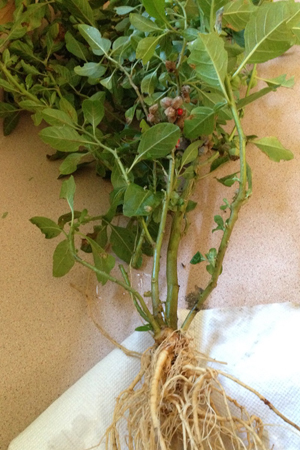 Ashwagandha (Withania somnifera): This root comes from Ayurveda, the ancient medical system of India, with the reputation to provide the strength of a stallion. This isn’t just for libido and male reproductive function, though it is good for that, but for overall vitality in all genders. Amongst the adaptogens, ashwagandha tends to be more balancing and promote calm, steady energy. Comparatively, adaptogens like ginseng, eleuthero and rhodiola are more zippy and can be over-stimulating for some.
Ashwagandha (Withania somnifera): This root comes from Ayurveda, the ancient medical system of India, with the reputation to provide the strength of a stallion. This isn’t just for libido and male reproductive function, though it is good for that, but for overall vitality in all genders. Amongst the adaptogens, ashwagandha tends to be more balancing and promote calm, steady energy. Comparatively, adaptogens like ginseng, eleuthero and rhodiola are more zippy and can be over-stimulating for some.
Ashwagandha also boosts thyroid function gently, mildly stimulating T3 and T4 thyroid hormone production. It has anti-inflammatory properties that make it useful for various forms of pain and inflammation, including Rheumatoid and osteoarthritis. It offers nervine properties, helping to ease anxiety and nourish the nerves and adrenals after post traumatic stress and other forms of physical and emotional stress. It also strengthens and modulates immune function, making it useful in both weak immune and autoimmune issues. Several human studies support its use in this range of issues, from libido and vitality to mood and arthritis.
You can use the dried root in any form – tea, tincture, capsule, powder – but it is classically simmered in milk, such as whole milk, coconut milk or almond milk. The fat helps drive ashwagandha to the nervous system. Ashwagandha works well simmered in broths and with chai spices, too. Aim for one teaspoon of dried root or powder per day, or follow the label’s directions. It may take a few weeks or months to see the effects build, and it is often taken for a full year to restore vitality.
If you’d like to grow ashwagandha, cultivate it like tomatoes, and harvest and dry the roots in the fall. While generally safe, avoid using ashwagandha with hyperthyroid disease, pregnancy and nursing, unless supervised by a professional herbalist or naturopathic doctor. This plant is in the nightshade family, so use caution or avoid it if you react to other nightshade plants like potatoes, tomatoes and peppers.
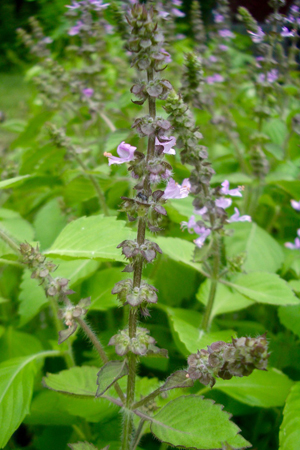 Holy Basil/Tulsi/Sacred Basil (Ocimum sanctum, syn. O. tenuiflorum): Holy basil is another calm-energy adaptogen from Ayurveda that also has nervine properties. It has a long history of use and promising preliminary studies, but unfortunately human studies are lacking. Nonetheless, this is one of my go-to herbs I grow in my garden.
Holy Basil/Tulsi/Sacred Basil (Ocimum sanctum, syn. O. tenuiflorum): Holy basil is another calm-energy adaptogen from Ayurveda that also has nervine properties. It has a long history of use and promising preliminary studies, but unfortunately human studies are lacking. Nonetheless, this is one of my go-to herbs I grow in my garden.
Use the aerial parts – leaves and flowers – to boost energy and mood, reduce stress, relieve anxiety and lift grief. It’s highly aromatic, and you’ll often notice improvement within minutes of taking it. Holy basil balances cortisol, a hormone associated with long-term stress and blood sugar imbalance. It also has anti-inflammatory, COX-2-inhibiting properties, which make it useful in protocols where stress, fatigue and pain coincide. And it supports mental cognition, boosts immune function and increases digestive juices.
Unlike most adaptogens, it’s relatively easy to grow and harvest holy basil in abundance. Unfortunately, even though holy basil is increasingly available in commerce, the quality on the market varies widely. I grow the kapoor variety, sold as an unnamed variety of “Sacred Basil” by High Mowing Organic Seeds. Kapoor is not the most potent variety of holy basil, but it is the easiest to grow in abundance, and I still get great results with it.
Use any of the forms of holy basil fresh or dry as tea, tincture or capsule. It makes an amazing hydrosol! It is an excellent candidate for a daily tea ritual. It’s generally well-tolerated, but avoid use in pregnancy or while nursing, unless supervised by a professional.
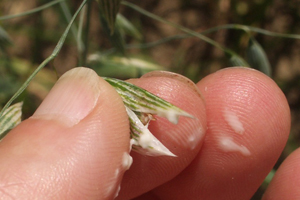 Milky Oat Seed (Avena sativa): This herb and the following plants are not adaptogens, but they are fabulous nervines. Milky oat seed comes from the fresh oat tops; for a few days in its life cycle, the premature oat grain exudes a milky latex when squeezed. This latex has profound benefits for the nervous system that are lost once the tops are dried. Therefore, we capture it in a fresh plant tincture. Whir the whole, fresh tops in a blender with high-proof alcohol for the best results. Yet, you could use glycerin, vinegar or a vinegar-honey base if alcohol needs to be avoided.
Milky Oat Seed (Avena sativa): This herb and the following plants are not adaptogens, but they are fabulous nervines. Milky oat seed comes from the fresh oat tops; for a few days in its life cycle, the premature oat grain exudes a milky latex when squeezed. This latex has profound benefits for the nervous system that are lost once the tops are dried. Therefore, we capture it in a fresh plant tincture. Whir the whole, fresh tops in a blender with high-proof alcohol for the best results. Yet, you could use glycerin, vinegar or a vinegar-honey base if alcohol needs to be avoided.
Though little modern research has been done, milky oat has a long history of medicinal use as a trophorestorative for the nervous-adrenal system. It’s specific for adrenal burnout, and when you feel both wired and tired. However, it’s a nice base for almost any formula for relaxation, energy or mood. Large, steady doses are preferred, up to a full teaspoon a few times a day, and it can take weeks to months for the benefits to build. Milky oat also has long been used for easing off addictive substances – to take the edge off cravings, withdrawal and irritability.
Several companies sell regular and alcohol-free milky oat liquid extracts. If you’d like to grow your own, find oat seeds as an organic cover crop. You can harvest and dry the rest of the plant, straw and older tops, while it’s still a happy green color for use as a nutritious tea. Milky oat is usually very safe and well tolerated, but avoid it if you’re allergic to oats. If you’re allergic to gluten, you may or may not react to milky oat seed.
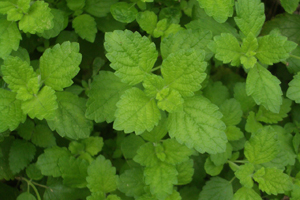 Lemon Balm (Melissa officinalis): This common garden herb emits a Lemon Pledge scent when you rub the fresh leaves. Then, compounds in the essential oils of lemon balm boost the mood while relieving stress and anxiety and improving cognition. Several clinical studies support its use for cognition, memory, attention and hyperactivity issues and anxiety. It’s gently calming – enough to help with sleep at night – but not usually so much to make you sleepy during the day. For sleep, I combine it with equal parts skullcap, passionflower, and spearmint and steep one heaping teaspoon of the dry mix in a small teacup of hot water for 20 minutes, then sweeten with honey. Tasty and effective!
Lemon Balm (Melissa officinalis): This common garden herb emits a Lemon Pledge scent when you rub the fresh leaves. Then, compounds in the essential oils of lemon balm boost the mood while relieving stress and anxiety and improving cognition. Several clinical studies support its use for cognition, memory, attention and hyperactivity issues and anxiety. It’s gently calming – enough to help with sleep at night – but not usually so much to make you sleepy during the day. For sleep, I combine it with equal parts skullcap, passionflower, and spearmint and steep one heaping teaspoon of the dry mix in a small teacup of hot water for 20 minutes, then sweeten with honey. Tasty and effective!
It lessens hyperthyroid states and stress-related heart palpitations, though I consider motherwort even stronger for this. It’s mildly bitter, enhancing gastric function – great for nervous indigestion and sub-par digestion. You can play around to find the dose that works best for you. Lemon balm also has antiviral properties for herpes and the flu, if taken at the very first tingle or onset, and applied externally in herpes outbreaks.
Like most mint-family herbs, lemon balm is loaded with antioxidants. One study found that adding lemon balm leaves to your salad exponentially increases the antioxidant activity of the vegetables. Even though lemon balm loses its aroma quickly after drying, it is still useful as tea. Fresh plant tincture works very well and helps capture the essential oils. I generally don’t use lemon balm capsules, but you could.
In all cases, products lose potency within one to three years, so homegrown or top-notch market quality is preferred. Lemon balm is very easy to grow in the temperate garden as a perennial. It prefers rich soil, part sun and modest moisture, but will grow almost anywhere and can spread over time. It’s generally quite safe for all ages. Use caution in hypothyroid disease and alongside mood and sedative meds, though it rarely causes problems.
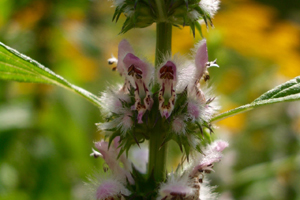 Motherwort (Leonurus cardiaca): Of all these herbs, motherwort tends to be the least well known and available in commerce, yet it is a phenomenal nervine and easy to grow almost anywhere. Like its mint-family relative, lemon balm, motherwort eases anxiety and hyperthyroid states. Its leaves and flowers are specific for stress that manifests in the heart – panic attacks that feel like heart attacks, anxiety that causes tachycardia or tightness in the chest. Although it is a heart tonic, it’s not strong enough for acute cardiovascular disease.
Motherwort (Leonurus cardiaca): Of all these herbs, motherwort tends to be the least well known and available in commerce, yet it is a phenomenal nervine and easy to grow almost anywhere. Like its mint-family relative, lemon balm, motherwort eases anxiety and hyperthyroid states. Its leaves and flowers are specific for stress that manifests in the heart – panic attacks that feel like heart attacks, anxiety that causes tachycardia or tightness in the chest. Although it is a heart tonic, it’s not strong enough for acute cardiovascular disease.
It has a mothering energy to it – sometimes tough love; this is a bitter and spiky plant! Yet it also provides nurturing love. It’s traditionally used for mothers and people who need a little mothering and is nice when you have a tendency to go on emotional rampages and feel undervalued in your relationships. Just a milliliter or two of the fresh plant tincture will often ease acute anxiety episodes in minutes, and you can also take it solo or in formula for long-term use. I frequently use it alongside conventional mood and anxiety medications without issue. Motherwort also has a reputation for easing PMS and menopausal hot flashes.
It is incredibly bitter, so the tea is too nauseating for most people to stomach. You could try extracting it in glycerin or vinegar if you need to avoid alcohol. Unfortunately, none of our liquid capsule companies sell it as a solo herb, which would be handy for those who don’t like liquids and can’t do alcohol. The dried herb is much less potent. Motherwort is generally safe. But it should not be used during pregnancy because it’s a potent emmenagogue, and you should be cautious if using it long-term alongside hypothyroid disease or mood and anxiety medications, though it’s not usually an issue.
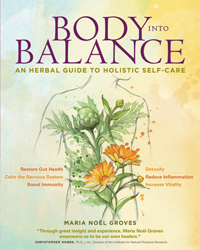 For all herbs, quality matters! If you’re not growing your own herbs and making your own medicine, check out good-quality products at Gaia Herbs, Herb Pharm, Mountain Rose Herbs, and Zack Woods Herb Farm, or look in your local community for a good hands-in-the-dirt herb farm that grows and makes their own products. For tips on making your own medicines, click here, or check out my book, Body into Balance: An Herbal Guide to Holistic Self Care.
For all herbs, quality matters! If you’re not growing your own herbs and making your own medicine, check out good-quality products at Gaia Herbs, Herb Pharm, Mountain Rose Herbs, and Zack Woods Herb Farm, or look in your local community for a good hands-in-the-dirt herb farm that grows and makes their own products. For tips on making your own medicines, click here, or check out my book, Body into Balance: An Herbal Guide to Holistic Self Care.

